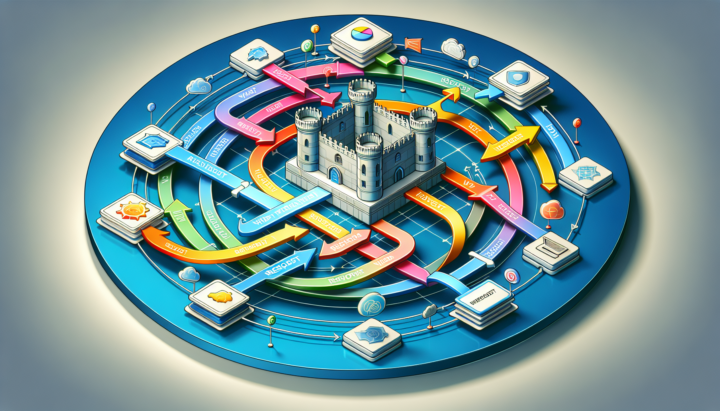The World Wide Web (WWW) is a system of linked public websites and web pages accessible through the internet. Designed for global information sharing, it has transformed how we access and interact with information. This article explores the Web’s basics, history, and its societal impact.
Key Takeaways
- The World Wide Web (WWW) is a distinct platform that enables access to interconnected public websites, facilitating global information sharing through hyperlinks.
- Tim Berners-Lee invented the WWW to enhance information dissemination among scientists, leading to the establishment of essential technologies like HTTP and HTML.
- The evolution of the Web from Web 1.0 to Web 3.0 signifies a shift towards a more decentralized internet focused on user utility, data security, and interactivity.
Understanding the World Wide Web (WWW): A Comprehensive Guide

The World Wide Web (WWW) is often misunderstood as being synonymous with the internet, but it is, in fact, a distinct entity. The WWW refers to all public websites and pages that can be accessed via the internet. It is a collection of interconnected web pages linked through hyperlinks, allowing users to navigate seamlessly between different resources.
At its core, the WWW was developed to facilitate information sharing among users globally, displaying information in various formats such as:
- text
- images
- audio
- video
It emerged as a universal system to connect different websites and documents, enabling easy access to a wealth of information.
Introduction
The World Wide Web emerged as a groundbreaking innovation to address the need for automated information-sharing among scientists worldwide. Initially conceived to improve communication and information dissemination within the scientific community, it quickly evolved into a platform with far-reaching implications for society at large.
The creation of a network of hypertext documents accessible through web browsers fundamentally changed how information is structured and retrieved.
The architecture, protocols, and key components that define the Web’s functioning are crucial for understanding its operation and significance.
Defining the World Wide Web
The World Wide Web (WWW) is a vast collection of public websites and web pages accessible via the internet. It was designed for global information sharing, connecting different websites and documents through a universal system. The defining concept of the WWW is its interconnected nature, with web pages linked through hyperlinks that allow users to navigate easily between resources. The World Wide Web Consortium oversees the development of standards for the web.
Web pages on the WWW can display a variety of information formats, including text, images, audio, and video. This versatility has made the Web an invaluable tool for communication, education, and entertainment. Each piece of content on the Web is part of a larger network, where hyperlinks serve as the bridges connecting different pieces of information.
The WWW is not just about accessing static information; it also allows for interactive experiences. Users can engage with content, follow links to additional resources, and even contribute their own information. This dynamic nature is what makes the Web a living, evolving entity.
How the World Wide Web Operates

The operation of the World Wide Web is founded on the Hypertext Transfer Protocol (HTTP), which facilitates communication between clients and servers. When a user requests a web page, the client’s web browser sends an HTTP request to the server hosting the page. The server then processes this request and sends back the appropriate HTTP response along with the requested web page.
This process of request and response is what enables users to access web pages and interact with the content. HTTP standardizes the way data is exchanged on the Web, ensuring that web browsers and servers can communicate effectively regardless of the underlying hardware or software.
The Birth and Evolution of the World Wide Web
The story of the World Wide Web begins with Tim Berners-Lee, who proposed the system that would eventually become the WWW while working at CERN in 1989. His vision was to create a global information system that could integrate various technologies, making information accessible to anyone, anywhere.
The Inception by Tim Berners-Lee
Tim Berners-Lee, an English computer scientist, invented the World Wide Web in 1989 to integrate computers, data networks, and hypertext into a global information system. His groundbreaking work led to the creation of the first web server and the first web browser, which he used to develop the first web page located at http://info.cern.ch/hypertext/WWW/TheProject.html.
The initial purpose of the WWW was to facilitate information sharing among scientists at CERN, but its potential quickly extended beyond the scientific community. By 1993, CERN made the World Wide Web technology publicly available, marking the beginning of a new era in information dissemination.
Berners-Lee’s contributions laid the foundation for the modern Web. His introduction of key innovations such as the Hypertext Transfer Protocol (HTTP), Hypertext Markup Language (HTML), and the concept of Uniform Resource Locators (URLs) revolutionized how we access and share information.
Web Browser Evolution
The evolution of web browsers played a crucial role in popularizing the World Wide Web. The first browser, Mosaic, was released by the National Center for Supercomputing Applications in 1993, developed by Marc Andreessen and others. Mosaic was the first user friendly mosaic browser to gain widespread popularity, thanks to its user-friendly interface and support for multimedia content.
Following Mosaic, Netscape Navigator was launched in late 1994 and quickly became the browser of choice for many users. It drove the rapid growth of the Web by making it more accessible and user-friendly. The advancements in these early browsers set the stage for the development of modern web browsers, which continue to evolve and enhance the user experience.
The transition from a text based web browser to graphical interfaces marked a significant milestone in the web browser evolution. This shift made the Web more visually appealing and easier to navigate, opening it up to a broader audience and paving the way for the explosion of the World Wide Web.
Key Components of the Web

The World Wide Web is built on several key components that work together to provide a seamless user experience. These components include HTML, URLs, and HTTP, each serving a distinct purpose in the functionality of the Web. Understanding these elements is essential to grasping how the Web operates and how we can interact with it.
HTML: The Building Block
HTML, or Hypertext Markup Language, is the primary format used for creating web documents. It serves as the foundational language for structuring content on web pages, enabling developers to organize text, images, and links in a coherent and visually appealing manner.
HTML allows developers to create interactive documents with various elements such as forms, tables, and multimedia content. This flexibility makes HTML the building block of web content, allowing for the creation of rich, dynamic web pages.
URLs: Online Addresses
A Uniform Resource Locator (URL) serves as a unique identifier for accessing components of the Web. URLs provide a standardized way to identify and locate resources, making it possible for web browsers to retrieve the desired content.
URLs not only pinpoint specific locations on the Web but also facilitate the retrieval of resources by browsers. They indicate the location of web pages and other content, ensuring that users can access the information they need with ease.
HTTP: Data Transfer Protocol
The Hypertext Transfer Protocol (HTTP) is essential for transferring data between servers and clients on the Web. It standardizes communication for accessing web pages, ensuring that data is transmitted and received efficiently.
HTTP is the foundational protocol that facilitates data exchange between web clients and servers, supporting the retrieval of web pages and other content. This standardized method of communication is what makes the Web accessible and functional.
Distinguishing the Web from the Internet
The World Wide Web is often mistaken for the internet, but they are distinct entities. The internet is the underlying infrastructure that supports various forms of communication, including email and file transfers, while the Web is a platform for retrieving and exchanging information via HTTP.
An effective analogy is to think of the internet as the roads and highways, with the World Wide Web representing the buildings and businesses along these roads. Each web resource is accessed via a unique address called a Uniform Resource Locator (URL), which helps users navigate the vast landscape of information available on the Web.
Accessing the World Wide Web
Accessing the World Wide Web involves the use of clients, such as computers or smartphones, and web server software that store the web pages requested by these clients. The interaction between clients and servers is what allows users to retrieve and view web content.
Using Web Browsers
Web browsers act as interfaces that enable users to navigate and retrieve information from the Web. Popular web browsers like Google Chrome, Firefox, and Microsoft Edge offer various features to enhance the user experience, such as bookmarks, history, and tabs.
Web browsers enable users to access web pages, interact with content, and follow links to additional resources. Modern web browsers provide functionalities that make navigating the Web seamless and intuitive.
Local vs. Remote Clients
Local clients access web pages stored on the same machine or local network, often resulting in faster performance compared to remote clients that fetch data over the internet. This reduced latency and quicker response time make local clients more efficient for accessing web content.
Remote clients, on the other hand, rely on web servers to retrieve information. This can introduce latency and affect response times based on network conditions, highlighting the importance of efficient data networks for optimal web performance.
The Future of the Web: From Web 1.0 to Web 3.0

The evolution of the Web has seen significant advancements from its early days as Web 1.0 to the more interactive and social Web 2.0. The future, known as Web 3.0, aims to create a more decentralized and open internet, enhancing user utility and data security.
A key aspect of Web 3.0 is Tim Berners-Lee’s vision for a Semantic Web, where computers can understand content context. This new era will leverage AI and machine learning to improve how information is processed, offering a more personalized and efficient user experience.
The Impact of the World Wide Web
Since its inception, the World Wide Web has transformed from a tool for scientific collaboration to a pivotal platform for everyday communication and commerce. It has revolutionized how information is shared and accessed globally, playing a crucial role in education, social interaction, and business.
The Web has enabled real-time, interactive exchanges, connecting users globally and locally, fostering a new form of social interaction characterized as ‘networked individualism’. This blend of online engagement and offline relationships has reshaped how we interact with one another and the world around us.
In education, the WWW has facilitated e-learning and access to vast resources, reshaping how knowledge is acquired and shared. The continuous innovation driven by the Web has fostered collaboration, creativity, and the rapid sharing of ideas, making it a fundamental part of daily life.
Summary
The World Wide Web has come a long way since its inception, evolving into a dynamic platform that connects people and information worldwide. From its foundational components like HTML, URLs, and HTTP, to the ongoing advancements in web browser technology, the Web continues to shape our digital landscape.
As we look to the future, the potential of Web 3.0 promises even greater innovations, enhancing how we interact with information and each other. The WWW remains a testament to human ingenuity and the relentless pursuit of knowledge, inspiring us to explore and harness its full potential.
Frequently Asked Questions
What is the main difference between the World Wide Web and the Internet?
The main difference between the World Wide Web and the Internet is that the World Wide Web is a system for sharing information through hyperlinks and web pages, whereas the Internet is the broader network that enables various types of data communication and services.
Who invented the World Wide Web?
The World Wide Web was invented by Tim Berners-Lee in 1989 during his time at CERN.
How do web browsers function?
Web browsers serve as interfaces for users to navigate and retrieve information from the internet by sending HTTP requests to web servers and displaying the resulting web pages. This fundamental process allows seamless access to online content.
What is a URL?
A URL (Uniform Resource Locator) serves as a unique identifier that enables users to locate and access resources on the World Wide Web. It is essential for navigating online content.
What are the key components of the World Wide Web?
The key components of the World Wide Web are HTML (Hypertext Markup Language), URLs (Uniform Resource Locators), and HTTP (Hypertext Transfer Protocol). These elements work together to facilitate web navigation and information sharing.